Gooseberries are a very unpretentious crop and can grow and bear fruit without any care. But at the same time, its lifespan is significantly reduced, the berries become smaller, and the yield decreases. Proper pruning of gooseberries extends the life and fruiting of the berry several times.
|
Pruning gooseberries begins from the moment of planting and continues throughout the entire period of growing the crop at the dacha. |
| Content:
|
Formation of gooseberries from planting to fruiting
Some novice gardeners mistakenly believe that pruning gooseberries is a secondary activity and do not pay due attention to it. In fact, without proper pruning, you cannot count on a good harvest of this crop.
Types of pruning
According to the purpose of pruning, there are:
- Sanitary. Carried out in case of damage to branches. Do it at any time of the year as needed.
- Formative. Performed annually in spring or autumn. Regulates the amount of growth and fruiting shoots.
- Rejuvenating. Mainly required by old bushes. Sometimes it is carried out on neglected plants, since without care the gooseberry quickly ages. Pruning is carried out in spring or autumn.
Gooseberries are pruned annually.
Why is it necessary to prune gooseberries every year?
The main reasons for annual pruning.
- The bushes are growing very much. Over the course of a year, they produce a large number of shoots; in addition, side shoots grow on existing branches. The plant becomes very thick and shaded. In dense bushes there are no berries in the middle; the entire harvest is formed on the peripheral branches. Very few flower buds form in the center; they lack both light and air. Removing excess branches promotes more active flowering and fruiting.
- Prevention of diseases and pests. Thickened bushes are heavily affected by diseases. Also, many pests develop and overwinter in the crown and in the tree trunks.
- Correct formation of culture. Allows you to regulate the number of fruiting shoots and young shoots. With regular and correct pruning, all branches are well illuminated by the sun, and the plant is well ventilated.
- Extending the life of gooseberries. The root system of the berry plant, unlike the crown, does not age for a long time and is capable of producing strong growth. Every year, a lot of young shoots are formed and without pruning, the roots go on to support existing branches, giving less and less growth. And a small number of zero shoots leads to rapid aging of the bush.
Conclusion. For long-term existence and good fruiting of gooseberries, pruning must be done annually.
The pruning procedure seems complicated and confusing only at first glance, but in fact it is easy to understand even for novice gardeners.
|
Pruning of berry bushes can be done in both spring and autumn. |
Timing for pruning
The main activities are carried out in the fall: old branches and excess growth, broken and damaged shoots are cut out. And in the spring, during inspection, the frozen and broken ones are cut out.
You can carry out the main pruning in the spring. At this time, all damaged, frozen, diseased branches are visible. Pruning is carried out during the period of swelling and bud opening. Weak, diseased and dry branches are clearly visible against the background of healthy blossoming shoots.
But gooseberries begin their growing season very early. Often at this time it is impossible to approach the crop, because it is still too dirty and damp.
How to prune seedlings when planting
Immediately after spring planting, all shoots are shortened by 2/3. Weak branches are cut off at the root.In gooseberries, like almost all crops, the aerial part is more developed than the roots, even if the seedling has a closed root system. The roots cannot meet the needs of the above-ground part for water and nutrients. And in the spring the shoots begin to grow and the load on the root system increases. It cannot meet the needs of the above-ground part, the growth of the bush slows down, the shoots weaken, and the gooseberry takes root slowly. With a powerful above-ground part and a weak root system, the crop may die.
When planting in spring, shortening the shoots is mandatory!
|
When shortening the branches, the balance between the tops and roots is restored. The cut branches do not require much nutrition, and the berry plant takes root well and develops in the future. |
When planting in autumn, it is not necessary to shorten the seedlings, although it is permissible. In autumn, the crop stops growing; the branches do not require much nutrients and water. In winter they will be covered with snow, and the seedlings will overwinter well.
But if the seedling is very powerful, with well-developed branches, then for the winter it is shortened by 1/3. In the southern regions with little snowy winters and frequent thaws, even when planting in autumn, gooseberries are cut by 2/3. In regions with harsh winters, small seedlings are covered.
Pruning young gooseberries
|
Step-by-step formation of a gooseberry bush |
The next year, at the end of summer, weak shoots are cut out, and powerful branches are shortened by half. As a result, in the 3rd year, strong shoots are formed from shortened shoots, as well as branches growing from the base of the bush, which will give rise to powerful bushes. They are overgrown with fruits, on which the main crop is formed.
If the seedling has weak shoots, then they are shortened by 2/3, and when strong zero growth appears, they are completely removed.
If weak branches are left, a small number of fruits will form on them, and the yields will be small. In 3-4 years, when the young growth grows and begins to bear fruit, the situation will gradually improve, but why wait so long?
The general scheme for the formation of gooseberries is as follows: every year 3-4 new shoots are left, growing in different directions, all the rest are cut out. Thus, after 5-6 years the bush will consist of approximately 20 branches of different ages. Gooseberries must be kept in this form for the entire subsequent period. We left 2 new shoots - 2 old ones were removed, if we left 3, then we removed 3.
To enhance the formation of root shoots, fertilizers are applied under the bush in full, and regular watering is carried out, preventing the soil from drying out. If you water the gooseberries well in the second half of summer (in the absence of precipitation), do moisture-recharging irrigation in the fall and apply the required fertilizers, then in the summer of next year a large number of shoots will appear and it will be possible to select the strongest shoots.
To enhance the growth of shoots in length, weekly watering is carried out in the spring. The water consumption rate for a one-year-old seedling is 5 l, for a 2-3 year old seedling it is 10-15 l. To retain moisture, the soil under the gooseberries is mulched. If it rains, no watering is required.
Formation lasts 5 years. From the age of 5, gooseberries begin to bear fruit. By this time, in the north and in the middle zone the bush should contain 10-14 branches of different ages, in the south 18-20 shoots of different ages.
Pruning fruiting gooseberries
To properly prune, you need to know the structure of the gooseberry bush.
The structure of the bushes
Zero shoots grow from the root collar. In summer they grow in length and do not branch; in autumn they are shortened by 1/3-1/2. The next year the shoot also grows in length, but lateral branches appear on it. Depending on weather conditions and agricultural technology, the amount of growth can be from 0.5 to 30 cm.
|
Diagram of a gooseberry bush by branching order: a - annual branch; b - two years; c - four-year-old; g - five years old |
Most gooseberry varieties branch slightly; they do not have increments of more than 2-3 orders of magnitude. But there are some highly branching varieties that have branches of the 5th-6th order.
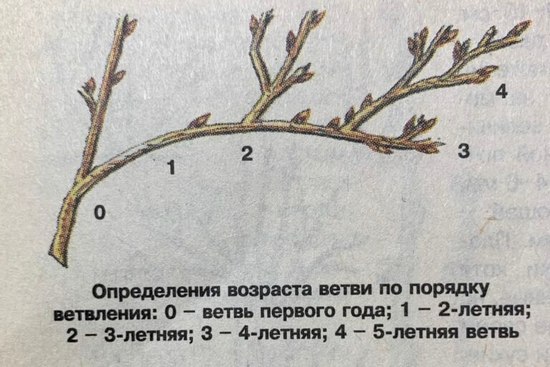 |
There are practically no fruits on the central branches of the gooseberry, which grow vertically upward in the center of the bush, and they do not bear fruit. The side branches are densely overgrown with fruits, and they are the most valuable. Depending on the variety, the fruits can be single or branched. Branching fruits also bear fruit annually, and there are berries on each branch. After several years of fruiting, in some varieties they sometimes sprout into a shoot, and such branches are more durable.
Fruitlets live for 3-4 years, then dry out, and since the main number of them is formed on branches of the 2nd-3rd order, then by the age of 5-6 years of the bush they begin to die off; by the age of 7 the branches practically dry out and do not bear fruit, so they should cut out. But often, on 6-8 year old branches, young shoots with good fruits, on which there are many berries, grow from the middle.
|
Such branches are pruned to a young fruit-bearing shoot, but it should be taken into account that the shoot on the old branch begins to bear fruit in the 3rd year. |
The age of the branches can also be determined by the location of the berries on them. On a young branch, berries are tied almost from the base to its top.As they grow, the lower fruits dry out and fall off and berries form from the middle of the branch to the top. On old stems, the fruits are preserved only at the top, and only here there are berries.
How to trim fruit-bearing bushes
Gooseberries enter the period of full fruiting from the age of 5. When full fruiting begins, full pruning of the bush begins. During the growing season and fruiting, it is necessary to notice which branches bear fruit better. Before pruning, they are inspected and the number of fruitlets and the presence of fruiting and growth buds are assessed. Fruit buds are more rounded and slightly protruding, shoot buds are flatter and pressed to the stem.
|
This is what a - single fruits look like, b - branching fruits |
It is not always the case that a branch stops bearing fruit at 6-7 years of age. Its condition depends on the illumination and agricultural technology of the crop. If the branches in the bush are located freely, without shading each other, then the age of their life and fruiting increases. When thickened and shaded, they age earlier and stop bearing fruit.
Therefore, when pruning gooseberries, pay attention not to the age of the fruiting shoots, but to their quality. If old shoots have good growth with numerous fruits, they are left, despite their age. On the contrary, if young branches have weak growth and few fruits, they are cut out.
Don't forget to read:
The best varieties of gooseberries with photos and reviews from gardeners ⇒
Autumn pruning
The main pruning of the crop is carried out in the fall. The bushes consist of branches of different ages. The root shoots are cut out, leaving 2-3 of the strongest replacement shoots to replace aging branches and 2-3 additional ones in case fruit-bearing branches freeze out in winter.Cut out all weak shoots, shoots growing inside the bush and twisted, as well as those affected by pests and diseased.
Branches that are 2-5 years old, if they are healthy, are not cut out. If the gooseberries have not been looked after for some time and thickening has occurred, then shoots that grow vertically upward (they practically do not bear fruit), as well as those with the smallest number of fruits, are cut out.
7-9 year old branches, with high agricultural technology and proper pruning, continue to bear fruit, but the fruitlets in the lower part of the shoot die off and fruiting moves to the tops of the growth. The growth on them is small and does not grow well with fruits. They usually have dried out tops and live only by lateral growths. Such branches are cut down to the base; even despite strong growth, they will still dry out in a year or two.
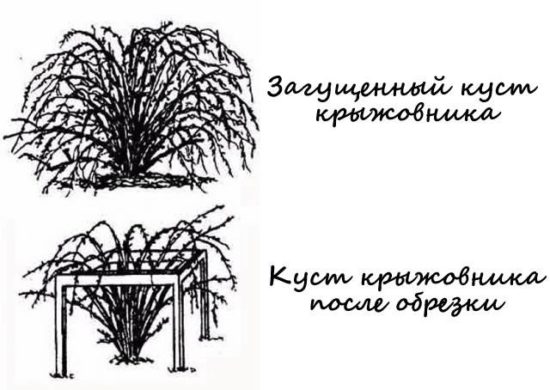 |
Remove all old, drying branches. They are clearly visible by the dark bark and the almost complete absence of growth. They usually begin to dry out immediately after fruiting.
Fruits on branches above the 4th order are short-lived, bear fruit poorly and are prone to sprouting into shoots. Therefore, on young branches, all branches of the 4th or more orders are removed, this, at the same time, prevents thickening of the bush.
Spring pruning
Let's take a step-by-step look at spring pruning of gooseberries
- Spring pruning is carried out before sap flow begins. Inspect the plantings. In the north, in the middle zone and in Siberia, during harsh winters, gooseberries often freeze.
- Remove all frozen, broken, twisted shoots.
- Then weak branches that do not grow well after winter are cut out.
- Cut out shoots lying on the ground and interfering with soil cultivation.
- If the fruits freeze in winter, then such branches are cut out; they are no longer productive.The shoot itself may continue to grow, but it will take several years before it becomes overgrown with fruits and bears fruit. Instead, a replacement shoot is left, which will give a decent harvest the next year.
- If the gooseberries have overwintered well, then cut out the 2 weakest young shoots, which were left as a safety net in case the main branches froze.
- When the upper part of the shoot freezes, it is cut back to living wood. If young shoots begin to appear on the gooseberry, they are cut out. Over the summer, many strong shoots will grow.
- Inspect young branches. If the young growth on them is less than 7-8 cm (it differs from the main shoot in having a lighter bark), then the branch is cut off, going down along it to the first strong branching.
- In early spring, all zero shoots of last year are shortened by 1/4, then they will branch. The cut should be above the bud, pointing outward, otherwise the shoot will grow inside the bush.
Annual growths at the ends of branches are not shortened, since it is on them that the main crop is formed. When pruned, they will not branch. When shortened, only shoots growing from the ground branch.
summer pruning
In summer, gooseberries are not pruned. Summer pruning is carried out in emergency cases.
- If damaged. Damaged shoots are removed partially or, if this is not possible, entirely.
- When the shoot dries out. If it suddenly begins to dry out in the summer, then it is removed immediately, without waiting for the end of the growing season.
- Some varieties of gooseberries produce a lot of root shoots, which creates excessive thickening and interferes with harvesting. In July, it is better to remove most of it, leaving 5 pieces, and during the main pruning, choose 2-3 of the best ones. Always leave replacement shoots growing in different directions.
All other pruning is done in spring or autumn.
Shortening pruning of zero shoots is not carried out in the summer, since they will branch and will not have time to become lignified before the onset of cold weather.
Rejuvenating pruning of old bushes
Anti-aging pruning should be carried out if you need to preserve a valuable variety, or on neglected plants when they have aged prematurely. If the bush is older than 30 years, then no pruning will help.
|
Rejuvenating pruning is the gradual removal of old branches and replacing them with young shoots. It is carried out in several stages. |
- In autumn, 1/3 of the old branches are cut out. In the fall, a bucket of manure or 2 buckets of humus are brought under the bush. Fertilizing leads to increased growth of zero shoots the following year.
- Next fall, the zero shoots are shortened by 1/4 of their length. This causes them to branch heavily in the summer of next year. At the same time, another 1/3 of the old shoots are removed.
- In the third autumn, the zero growths are shortened by 1/4 and the remaining old shoots are cut out.
- Zero shoots that grow the next year are also shortened by 1/4.
Pruning the entire bush at the root at once is undesirable. Then a lot of annual shoots will appear at once, which will have to be thinned out and the gooseberries formed over the course of 4-5 years, and this delays the onset of full fruiting. Gradual replacement of old branches makes it possible to obtain decent yields after 3 years. In addition, if the bush is old, if all the shoots are removed at once, the root system may not cope and die.
Do not miss:
Main gooseberry diseases, description, photos and methods of treatment ⇒
The most dangerous gooseberry pests and how to combat them ⇒
Conclusion
With proper pruning, gooseberries can bear fruit regularly for 30-40 years.Without it, the plant ages already at 10-12 years, yields gradually decrease, and then stop completely.
In this video the candidate sat down. household Science Yulia Kondratenok very clearly and in detail explains how to properly prune gooseberries in order to get a good harvest of berries.
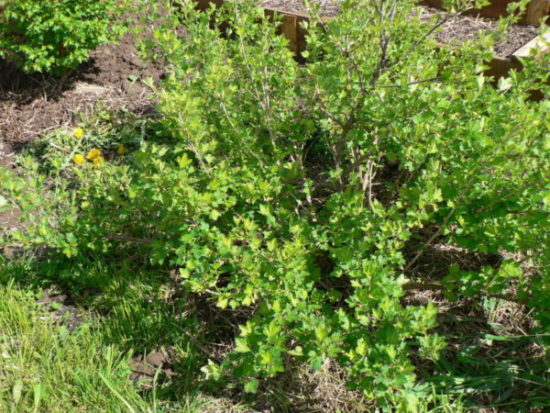
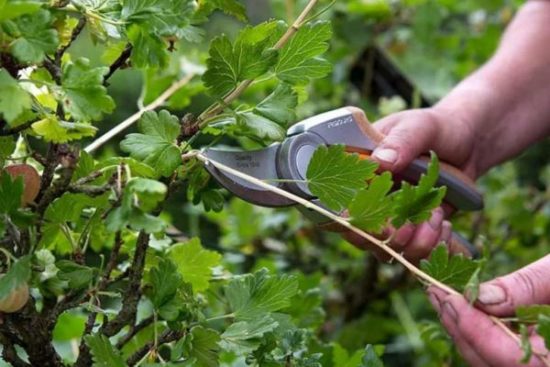
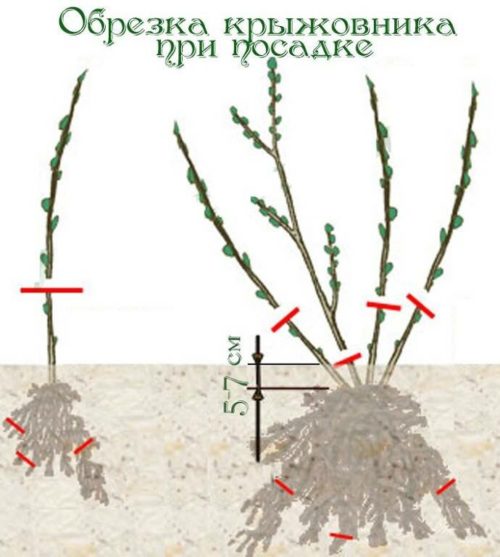
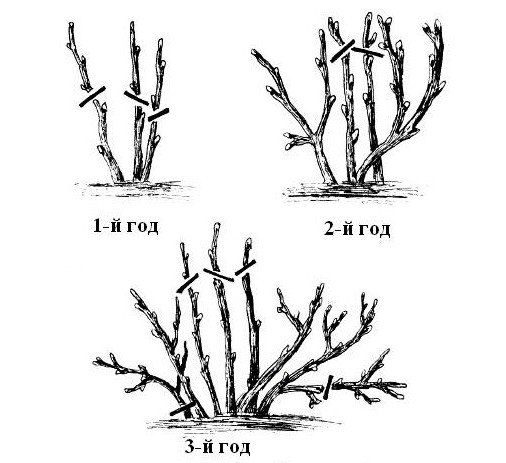
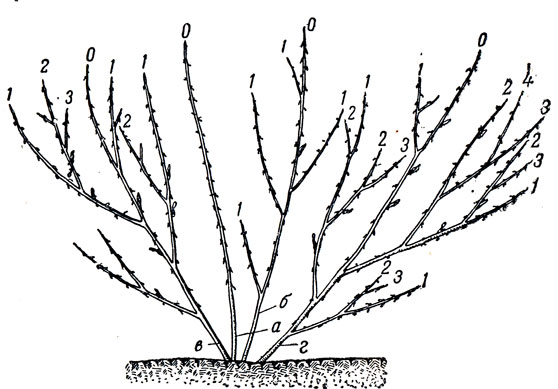
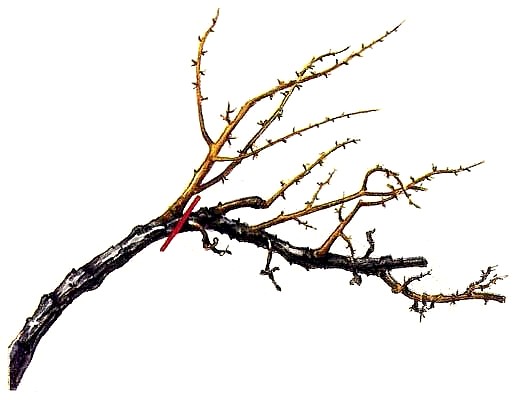
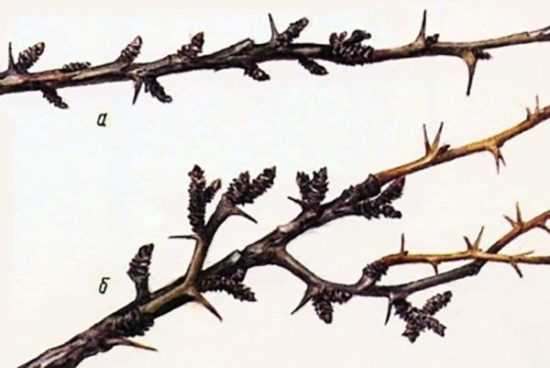
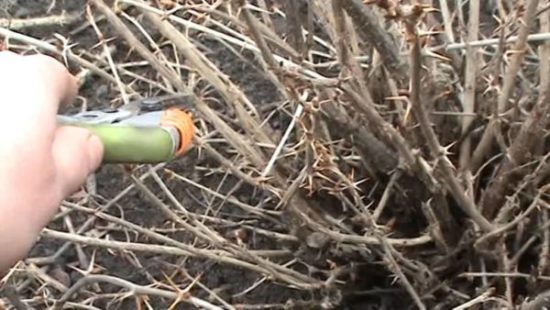

 CUCUMBERS NEVER GET SICK, I'VE BEEN USING ONLY THIS FOR 40 YEARS! I SHARE A SECRET WITH YOU, CUCUMBERS ARE LIKE THE PICTURE!
CUCUMBERS NEVER GET SICK, I'VE BEEN USING ONLY THIS FOR 40 YEARS! I SHARE A SECRET WITH YOU, CUCUMBERS ARE LIKE THE PICTURE! You can dig a bucket of potatoes from each bush. Do you think these are fairy tales? Watch the video
You can dig a bucket of potatoes from each bush. Do you think these are fairy tales? Watch the video
 How our fellow gardeners work in Korea. There is a lot to learn and just fun to watch.
How our fellow gardeners work in Korea. There is a lot to learn and just fun to watch. Eye trainer. The author claims that with daily viewing, vision is restored. They don't charge money for views.
Eye trainer. The author claims that with daily viewing, vision is restored. They don't charge money for views. A 3-ingredient cake recipe in 30 minutes is better than Napoleon. Simple and very tasty.
A 3-ingredient cake recipe in 30 minutes is better than Napoleon. Simple and very tasty. Therapeutic exercises for cervical osteochondrosis. A complete set of exercises.
Therapeutic exercises for cervical osteochondrosis. A complete set of exercises. Which indoor plants match your zodiac sign?
Which indoor plants match your zodiac sign? What about them? Excursion to German dachas.
What about them? Excursion to German dachas.
This is the best article about pruning gooseberries that I have read on the Internet. I searched through so many sites, but everywhere the same thing was written, like a carbon copy, incomprehensible and uninformative, it is not clear which branches to cut, how to determine their age, etc. Here everything is very clear, detailed, accessible, visual, for which many thanks to the author of this article! Now I know how to distinguish, for example, zero branches from two-year-old ones, etc., what old branches look like, how exactly they need to be pruned, and why one-year-old growths cannot be pruned - for me this is very valuable information that I learned right here on this site . Once again many thanks to the author!
I am very glad, Natalya, that my article helped you learn how to prune gooseberries. The thing is that for many years now, every spring I have been pruning my gooseberries and I know well how to do it.